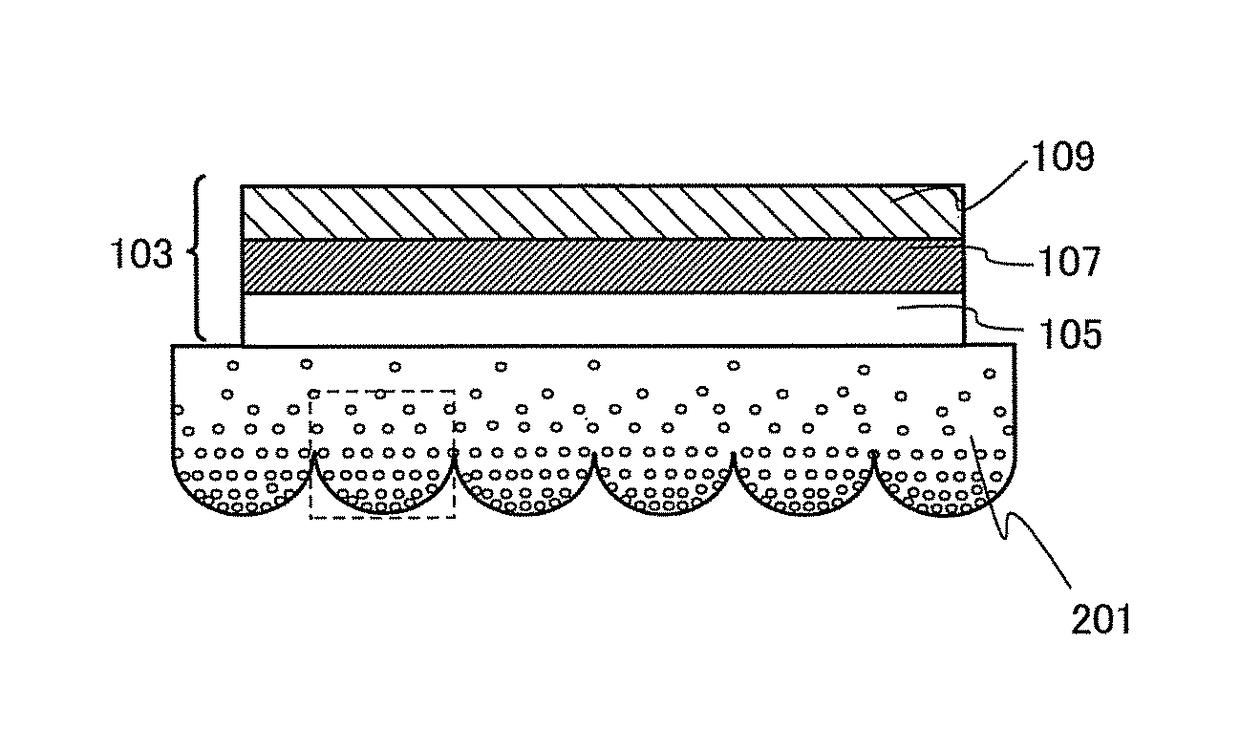Optical element, light-emitting device, lighting device, and method for manufacturing optical element
a technology of light-emitting elements and optical elements, which is applied in the direction of lighting and heating apparatus, instruments, other domestic objects, etc., can solve the problems of significant light loss and the inability to achieve 100% light extraction efficiency of solid-state light-emitting elements, and achieve the effect of efficient light extraction and high efficiency
- Summary
- Abstract
- Description
- Claims
- Application Information
AI Technical Summary
Benefits of technology
Problems solved by technology
Method used
Image
Examples
embodiment 1
(Embodiment 1)
[0040]In this embodiment, an optical element according to one embodiment of the present invention and a light-emitting device including the optical element are described with reference to FIGS. 1A and 1B and FIGS. 2A to 2C.
[0041]As illustrated in FIG. 1A, an optical element 101 has one plane which is in contact with a solid-state light-emitting element 103 and the other plane which is in contact with the air.
[0042]The solid-state light-emitting element 103 includes a transparent electrode 105 which is in contact with the optical element 101, a light-emitting region 107 provided over the transparent electrode 105 and emitting light toward the transparent electrode 105, and a reflective electrode 109 provided over the light-emitting region 107.
[0043]As examples of the solid-state light-emitting element 103, an organic EL element, an inorganic EL element, and an LED can be given. The shape of the solid-state light-emitting element is not particularly limited and may be ci...
embodiment 2
(Embodiment 2)
[0110]In this embodiment, a method for manufacturing an optical element according to one embodiment of the present invention is described with reference to FIGS. 3A to 3C and FIGS. 4A to 4C.
[0111]The optical element manufactured by the method described in this embodiment is a flat organic resin member into which bubbles are injected so that an apparent refractive index gradually decreases from one plane toward the other plane.
[0112]In the first step, an organic resin 303 is provided in molds 301 to be shaped as illustrated in FIG. 3A.
[0113]The molds 301 are a pair of molds of an upper mold 301a and a lower mold 301b, which are set between an upper heating plate 305 and a lower heating plate 307 of a heat press. Heat and pressure can be applied to the molds 301 through the upper heating plate 305 and the lower heating plate 307 of the heat press. Further, the upper heating plate 305 and the lower heating plate 307 are supplied with heat by respective heat sources, so th...
embodiment 3
(Embodiment 3)
[0143]In this embodiment, a solid-state light-emitting element included in a light-emitting device according to one embodiment of the present invention is described. In this embodiment, an organic EL element is used as the solid-state light-emitting element. An example of an organic EL element is described with reference to FIGS. 7A to 7C.
[0144]A light-emitting element illustrated in FIG. 7A includes a transparent electrode 105, a light-emitting region 107 over the transparent electrode 105, and a reflective electrode 109 over the light-emitting region 107.
[0145]In the light-emitting device described in this embodiment, the transparent electrode 105 functions as an anode and the reflective electrode 109 functions as a cathode; however, the present invention is not limited thereto. In other words, a structure in which the transparent electrode 105 functions as a cathode and the reflective electrode 109 functions as an anode may be employed.
[0146]The light-emitting regio...
PUM
| Property | Measurement | Unit |
|---|---|---|
| diameter | aaaaa | aaaaa |
| refractive index | aaaaa | aaaaa |
| refractive index | aaaaa | aaaaa |
Abstract
Description
Claims
Application Information
 Login to View More
Login to View More - R&D
- Intellectual Property
- Life Sciences
- Materials
- Tech Scout
- Unparalleled Data Quality
- Higher Quality Content
- 60% Fewer Hallucinations
Browse by: Latest US Patents, China's latest patents, Technical Efficacy Thesaurus, Application Domain, Technology Topic, Popular Technical Reports.
© 2025 PatSnap. All rights reserved.Legal|Privacy policy|Modern Slavery Act Transparency Statement|Sitemap|About US| Contact US: help@patsnap.com



